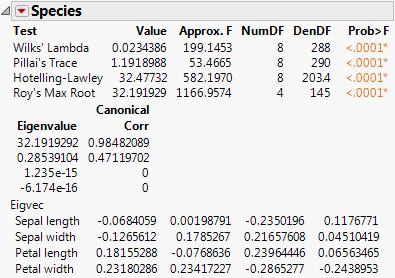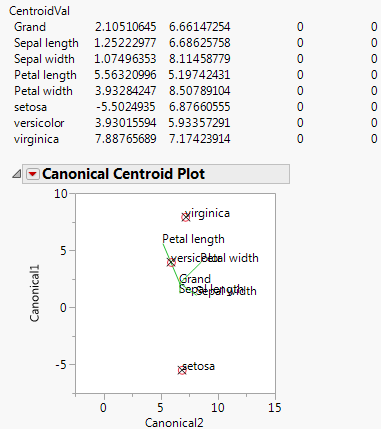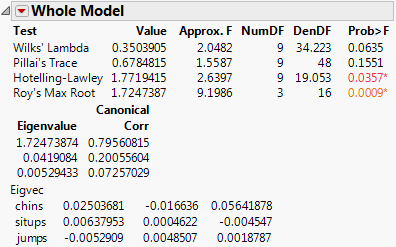Set up custom tests of effect levels using the Custom Test option.
Note: For instructions on how to create custom tests, see Custom Test in Standard Least Squares Report and Options.
Displays the eigenvalues and eigenvectors of the  matrix used to construct multivariate test statistics. See Test Details.
matrix used to construct multivariate test statistics. See Test Details.
 matrix used to construct multivariate test statistics. See Test Details.
matrix used to construct multivariate test statistics. See Test Details.Plots the centroids (multivariate least squares means) on the first two canonical variables formed from the test space. See Centroid Plot.
Saves variables called Canon[1], Canon[2], and so on, as columns in the current data table. These columns have both the values and their formulas. For an example, see Save Canonical Scores. For technical details, see Canonical Details.
Note: The Contrast command is the same as for regression with a single response. See the LSMeans Contrast in Standard Least Squares Report and Options, for a description and examples of the LSMeans Contrast commands.
|
1.
|
The Iris data (Mardia et al. 1979) have three levels of Species named Virginica, Setosa, and Versicolor. There are four measures (Petal length, Petal width, Sepal length, and Sepal width) taken on each sample.
|
2.
|
Select Analyze > Fit Model.
|
|
3.
|
|
4.
|
|
5.
|
|
6.
|
Click Run.
|
|
7.
|
|
8.
|
Click Run.
|
|
9.
|
From the red triangle menu next to Species, select Test Details.
|
Figure 8.4 Test Details
The Centroid Plot command (accessed from the red triangle next to Species) plots the centroids (multivariate least squares means) on the first two canonical variables formed from the test space, as in Figure 8.5. The first canonical axis is the vertical axis so that if the test space is only one dimensional the centroids align on a vertical axis. The centroid points appear with a circle corresponding to the 95% confidence region (Mardia et al. 1979). When centroid plots are created under effect tests, circles corresponding to the effect being tested appear in red. Other circles appear blue. Biplot rays show the directions of the original response variables in the test space. See Details for Centroid Plot Option.
Figure 8.5 Centroid Plot and Centroid Values
Saves columns called Canon[i] to the data table, where i refers to the ith canonical score for the Y variables. The canonical scores are computed based on the  matrix used to construct the multivariate test statistic. Canonical scores are saved for eigenvectors corresponding to nonzero eigenvalues.
matrix used to construct the multivariate test statistic. Canonical scores are saved for eigenvectors corresponding to nonzero eigenvalues.
 matrix used to construct the multivariate test statistic. Canonical scores are saved for eigenvectors corresponding to nonzero eigenvalues.
matrix used to construct the multivariate test statistic. Canonical scores are saved for eigenvectors corresponding to nonzero eigenvalues.|
1.
|
|
2.
|
From the red triangle menu next to Whole Model, select Test Details.
|
|
3.
|
From the red triangle menu next to Whole Model, select Save Canonical Scores.
|
The details list the canonical correlations (Canonical Corr) next to the eigenvalues. The saved variables are called Canon[1], Canon[2], and so on. These columns contain both the values and their formulas.
To obtain the canonical variables for the X side, repeat the same steps, but interchange the X and Y variables. If you already have the columns Canon[n] appended to the data table, the new columns are called Canon[n] 2 (or another number) that makes the name unique.
|
1.
|
|
2.
|
Select Analyze > Fit Model.
|
|
3.
|
|
4.
|
|
5.
|
|
6.
|
Click Run.
|
|
7.
|
|
8.
|
Click Run.
|
|
9.
|
From the red triangle menu next to Whole Model, select Test Details.
|
|
10.
|
From the red triangle menu next to Whole Model, select Save Canonical Scores.
|
Figure 8.6 Canonical Correlations
The output canonical variables use the eigenvectors shown as the linear combination of the Y variables. For example, the formula for Canon[1] is as follows:
0.02503681*chins + 0.00637953*situps + -0.0052909*jumps
 matrix used in computing the multivariate test statistics.
matrix used in computing the multivariate test statistics. matrix, or equivalently of
matrix, or equivalently of  .
.

